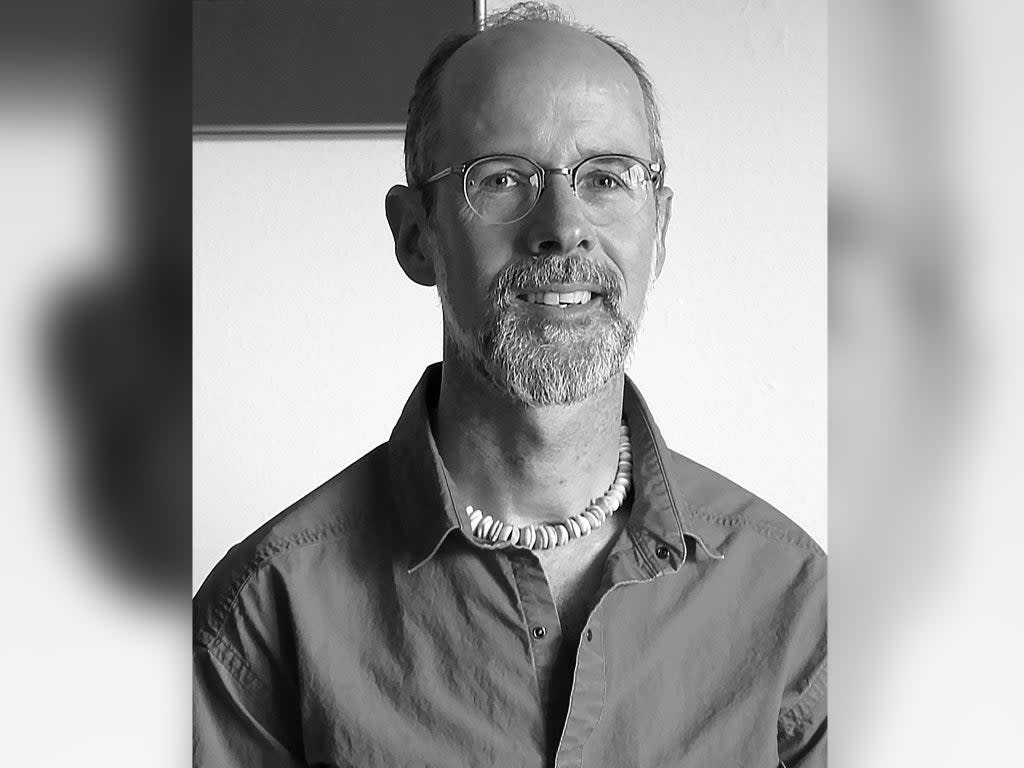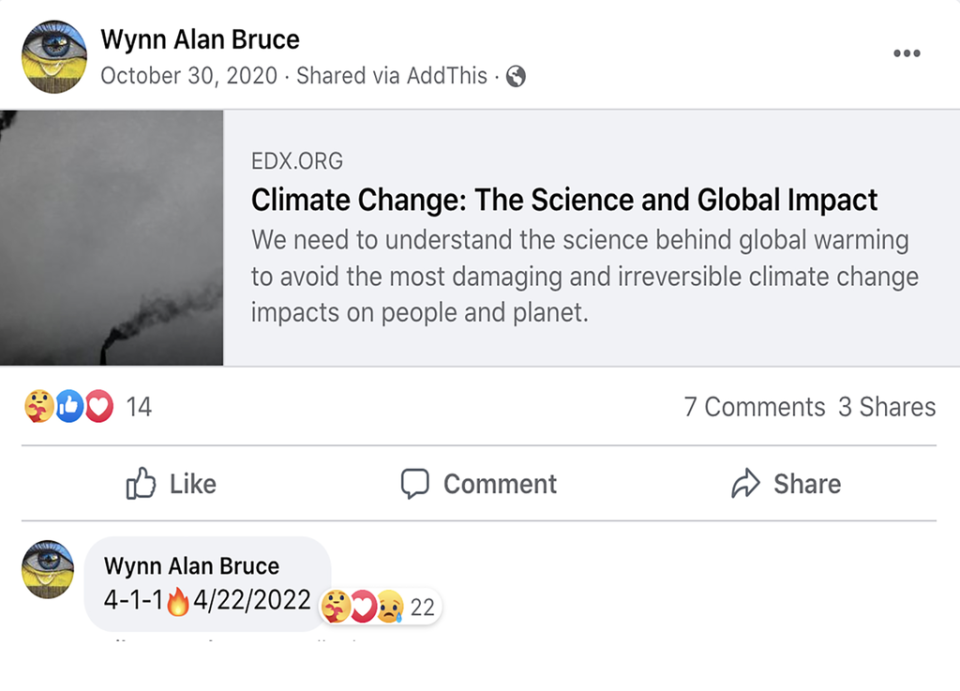Wynn Alan Bruce: What we know about the climate activist who died setting himself on fire at the Supreme Court

Climate activist Wynn Alan Bruce died 24 hours after setting himself on fire on the steps of the Supreme Court on Earth Day.
A Colorado photojournalist, Mr Bruce, 50, suffered critical injuries in the 22 April incident on the plaza in front of the court. He was airlifted to hospital, where he died the following day.
Capitol Police, Supreme Court Police, and DC police all responded to the incident, which occurred at around 6.30pm.
“A medical helicopter just landed near the Capitol for a medical emergency. This is not a public safety issue,” Capitol Police tweeted.
Here is everything we know about what led to his death.
Cryptic Facebook post with fire emoji and death date
Mr Bruce ran a portrait photo studio in Boulder, and his social media account was filled with posts about the environment and Buddhism.
He also left a cryptic post on his Facebook page with a fire emoji and the date of his death – “4/22/2022”. The post appears to have been edited a few days before his death.

Death planned a year in advance
Dr K Kritee, a Buddhist priest from Boulder, wrote on Twitter that Mr Bruce had been planning to self-immolate for at least a year.
“This guy was my friend. He meditated with our sangha,” she said.
“This act is not suicide. This is a deeply fearless act of compassion to bring attention to climate crisis. We are piecing together info but he had been planning it for at least one year. #wynnbruce I am so moved.”
USCP advises a helicopter landed at the Supreme Court building for a medical issue, according to media reports, a man attempted to set himself on fire in front of the building. pic.twitter.com/PLHDMJ1dlM
— ً (@IntelDoge) April 22, 2022
Dr Kritee also shared a quote from Buddhist monk Thích Nhất Hạnh referring to the practice of Vietnamese setting themselves on fire in protest at the Vietnam War in the 1960s.
“To express will by burning oneself, therefore, is not to commit an act of destruction but to perform an act of construction, that it, to suffer and die for the sake of one’s people,” the message read.
Dr Kritee told The New York Times that she wasn’t entirely sure of his intentions but that “people are being driven to extreme amounts of climate grief and despair” and that “what I do not want to happen is that young people start thinking about self-immolation”.
She added that had she known about his plans ahead of time, she and others would have urged Mr Bruce not to do it.
In a letter to civil rights icon the Reverend Martin Luther King Jr in 1965, Thích Nhất Hạnh wrote about the Vietnamese monks who burned themselves to protest the Vietnam War.
“The press spoke then of suicide, but in the essence, it is not. It is not even a protest,” Thich Nhat Hanh wrote.
The Zen Buddhist master died in January. Mr Bruce commemorated the passing on his Facebook account.
“To burn oneself by fire is to prove that what one is saying is of the utmost importance,” Thích Nhất Hạnh added in his letter to Dr King. “There is nothing more painful than burning oneself. To say something while experiencing this kind of pain is to say it with utmost courage, frankness, determination, and sincerity.”
Park Service helicopter lands on steps of Supreme Court after man tries to set himself on fire pic.twitter.com/jVEsgvEyas
— Chad Pergram (@ChadPergram) April 22, 2022
In other Facebook posts as far back as April 2020, Mr Bruce criticized “war profiteers,” former President Donald Trump, and collective climate change inaction.
He praised Swedish climate activist Greta Thunberg, 19, shared quotes from Dr King, and in March he wrote about the need for “compassion” with refugees from the war in Ukraine.
‘Clean air matters’
Mr Bruce appeared to belong to the Shambala, a Buddhist organisation based in Boulder and frequently shared quotes from Buddhist teachers like Chögyam Trungpa.
His final post from 28 March reads: “This is not humor. IT is all about breathing,” followed by: “Clean air matters.”
A LinkedIn profile that appeared to belong to Mr Bruce stated he was a photojournalist who had previously attended the Community College of Denver and Front Range Community College.
Supreme court heard environmental case
The Supreme Court heard arguments in a case in late February that could restrict or possibly remove the ability of the Environmental Protection Agency to control pollution.
The conservative majority on the court has shared scepticism of the court’s authority to regulate carbon emissions, indicating that a decision from the justices could hamper the Biden administrations efforts to fight back against climate change.
Friends and activists pay tribute
Mr Bruce’s Facebook page was inundated with messages from friends and activists offering their condolences.
Danielle Gager wrote: “Thank you for the act of compassion you bravely did. I’m sorry you aren’t here now. But what you did for the world took so much to do.”
Close friend April Lyon said his death was “heartbreaking”.
“I meditated and danced with Wynn for many years and saw him as a kind and compassionate man. I don’t know his motive, but my take is that as activists, we have to be careful not to sacrifice ourselves for the cause.”
Others were critical of what they claimed were Mr Bruce’s “misguided view of climate change”.
Twitter users also lauded Mr Bruce for his activism, with one account holder writing that he “made the ultimate sacrifice to save us from self-destruction. Let Wynn Alan Bruce’s #EarthDaySacrifice be remembered as the turning point. If not now, when will we turn from death and destruction to choose life?”
“Wynn Alan Bruce died yesterday so everyone could knock off the ‘happy’ Earth Day crap,” another Twitter user wrote. “His death was an act of generosity, self-sacrifice, giving his life so others might pay more attention to the degree of the threat to our climate, and what needs to be done. He’s a hero.”
Roberto Arrucha wrote that Mr Bruce “gave his life so we can pay attention to our collective suicidal path”.
“To set yourself on fire and die for a cause demands that we take the time to learn his name and think about what he stood for,” Jeremy Radick added.
Fellow climate activist died in 2018
In 2018, climate activist David Buckel, 60, died by self-immolation in Prospect Park in Brooklyn in protest against the use of fossil fuels.
Shortly before his death, Mr Buckel emailed a suicide note to several media outlets explaining his actions.
“Most humans on the planet now breathe air made unhealthy by fossil fuels, and many die early deaths as a result — my early death by fossil fuel reflects what we are doing to ourselves.”
Mr Buckel had been a prominent civil rights lawyer and LGBTQ activist and ran the marriage-equality project at Lambda Legal.
Previous self-immolations in the Washington-area
In 2019, Arnav Gupta burned himself in front of the White House. He later died of his injuries and a motive was never established.
Yemeni-born FBI informant Mohamed Alanssi survived after setting himself on fire in front of the White House in 2004 to protest his treatment by the government.
In 1965, Norman Morrison, a Quaker, burned himself to death outside the Pentagon to protest the Vietnam War.
If you are experiencing feelings of distress and isolation, or are struggling to cope, The Samaritans offers support; you can speak to someone for free over the phone, in confidence, on 116 123 (UK and ROI), email jo@samaritans.org, or visit the Samaritans website to find details of your nearest branch.
If you are based in the USA, and you or someone you know needs mental health assistance right now, call National Suicide Prevention Helpline on 1-800-273-TALK (8255). The Helpline is a free, confidential crisis hotline that is available to everyone 24 hours a day, seven days a week.
If you are in another country, you can go to www.befrienders.org to find a helpline near you.

